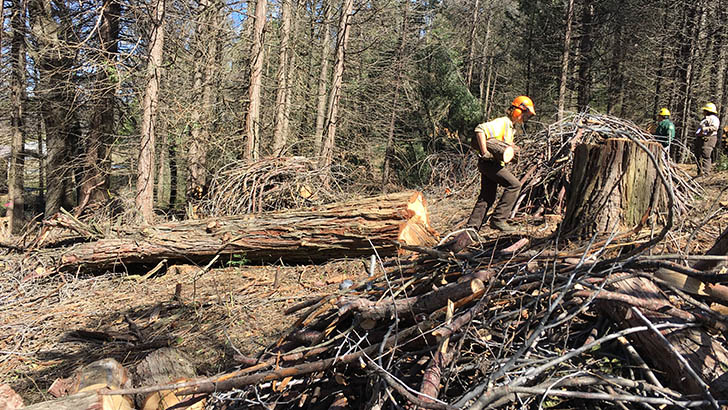
(Photo: USDA/Raymundo Valencia)
While the COVID-19 crisis continues to unfold, leaders within California’s forestry management world have not lost sight of another crisis in our midst: The ongoing threat of wildfires.
Among those working on solutions has been the Joint Institute for Wood Products Innovation, which operates under the umbrella of the California Board of Forestry and Fire Protection.
In a new study, the Institute has concluded that development of innovative wood products holds significant potential for driving multiple benefits in California. Those benefits include creating healthier forests through sustainable forest management and restoration, reducing wildfire risks from overgrown forests, promoting carbon storage in long-lived wood products, and strengthening local capacity and regional collaborations that can lead to greater economic resilience.
The study, “Literature Review and Evaluation of Research Gaps to Support Wood Products Innovation,” was developed by the Institute in conjunction with a team of researchers led by the University of California, Berkeley.
The size and intensity of California wildfires have grown dramatically in recent years due to decades of fire suppression, droughts, insect infestations, and a changing climate. Not only are lives, property, businesses and public health threatened in both rural and urban areas, but also the ecosystem benefits that healthy forests provide, including water supplies, native biodiversity, and carbon storage.
The Institute was established through an Executive Order to address the wildfire crisis, issued by Governor Jerry Brown in May 2018. The Institute’s purpose is to facilitate the development and expansion of a robust and sustainable forest products market sector in California, including identifying market and workforce gaps, fostering innovations, and making recommendations for state and federal policy changes.
The study reviewed several types of commercial uses for excess woody materials in forests and highlighted three particularly promising wood product categories:
- Mass timber products including panels, beams and columns used for building construction.
- Liquid and gaseous transportation fuels.
- Chemically and thermally treated wood products providing high durability features.
According to the document, such products have “sufficient commercial and technical readiness, and potential market size, to justify increased public and private investments in their development.” Other less mature technologies also hold potential and merit continued monitoring.
The study articulated several ways the state could foster a more supportive policy environment for wood products innovation, including supporting science and engineering research capacity, building markets, incentivizing regional actions and promoting rural economic development, and accounting for the carbon sequestration benefits that can accrue through greater use of wood products. The Institute’s study explained that it is imperative that “system-wide changes in forest management and forest product innovation” be undertaken.
The study highlighted a key finding contained in the California Economic Summit’s recent report on the wildfire crisis, which explained that at least $10 billion over the next 10 years will be required to address the landscape-level restoration that is needed across public and private forest lands in California. That report, “California’s Wildfire Crisis: A Call to Action,” urged a statewide marshalling of resources and actions, including development of vibrant forest-based industries through environmentally sustainable practices, to restore forest health, revitalize rural communities, and sequester carbon.
The new study by the Institute noted that because the Institute is a state entity that brings together academic expertise and stakeholder networks, it is poised to facilitate opportunities for cross-sector partnerships to advance its purpose. Moving forward, the Institute will focus on several key programmatic focus areas:
- Identifying actions and policies that attract investment capital and expand markets for innovative wood products.
- Training and education to address the need for a skilled workforce.
- Stewarding innovative financing to attract private capital.
- Improving stakeholder engagement and effectiveness through convening activities.
- Public education, including fostering understanding about the benefits of forest products that are a byproduct of sustainable forest management.
The report explained the multiple benefits that could be achieved through advancing wood product industries, including meeting the ambitious goals within the California Forest Carbon Plan by embedding carbon in structural materials and other wood products as well as in trees and soils within healthy forests.

